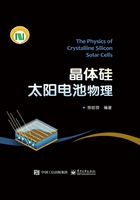
6.2 热平衡状态下的pn结
当pn结没有外界作用时,处于热平衡状态;当存在光、热、电等外界作用时,pn结处于非热平衡状态;当外界作用不太强时,可认为pn结处于准热平衡状态。
6.2.1 热平衡状态下pn结的费米能级
在热平衡条件下,没有外界作用时,由电场引起的载流子漂移电流Jdrift与浓度梯度引起的扩散电流JD抵消,通过pn结的净电流为零。
对于空穴,根据第5章中的式(5-52),空穴电流密度的表达式为

因为电场作用力等于电子势能梯度的负值,利用爱因斯坦关系式,得到:

将式(4-54)代入式(6-2)可得:

由此得到净空穴电流密度的表达式,即

由此可知:

类似地,可以得到电子电流密度的表达式:

由此可知:

可见,在热平衡状况下,净电子电流密度和净空穴电流密度等于零的条件是要求在整个样品内费米能级为与x无关的常数,如图6-3所示。

图6-3 热平衡条件下pn结的能带结构和空间电荷分布
6.2.2 pn结的内建电势
pn结的结区存在空间电荷,其静电势ψ与电荷密度ρ的关系式可由静电学中泊松方程求出,再利用电场强度与电势的关系式,可得:

式中,电荷密度ρ为
ρ=q(∑N+p-n)
式中,∑N为包括电离的掺杂剂电荷和其他陷阱电荷在内的净电荷总和。
载流子从中性区向结区移动时,将遇到一个狭窄的过渡区。在此过渡区内,由部分杂质电离化形成的空间电荷被可移动的载流子补偿。经过过渡区后,再往前就是载流子完全耗尽的区域,可移动的载流子的浓度为零。这个区域也就是前面所说的势垒区和空间电荷区。对于典型的硅pn结,过渡区的宽度比耗尽区的宽度小很多。通常可忽略过渡区的宽度,采用耗尽层来近似,假设耗尽层的电荷分布呈箱形,即耗尽层的电荷可用矩形分布表示,如图6-3(d)所示。图中,xp和xn分别表示p型区耗尽层和n型区耗尽层的宽度。
设n型区有均匀的浓度为ND的单一种类的施主杂质,p型区有均匀的浓度为NA的单一种类的受主杂质,且所有杂质都是电离的,同时不考虑其他陷阱电荷,则上式可简化为

于是式(6-6)可表示为

设势垒区的正、负空间电荷区的宽度分别为-xn和xp,交界面位于x=0处。离开pn结较远的区域(x≤-xn,x≥xp)是电中性的,总的空间电荷密度为零,即

式(6-8)可简化为

对于p型中性区,在热平衡条件下,设ND=n=0,则p=NA,代入式(4-87)后可得:

于是p型中性区中相对于费米能级的静电势ψBp在矩形近似下为

静电势与电子势能方向相反。
同理可得n型中性区中相对于费米能级的静电势ψBn:

热平衡下,在p型中性区和n型中性区之间总的静电势之差即为内建电势Vbi:

内建电势(或内建电势差)也称自建电压或内建电压。由式(6-13)可见,在一定温度下,pn结两侧掺杂浓度高,则自建电压Vbi大;禁带宽度大,ni小,自建电压Vbi也大。
pn结内建电势所对应的电子势能之差,表示了能带的弯曲量qVbi和势垒高度。
说明
式(6-13)也可借助第4章中引入的准费米能级概念推导出来。
由图6-2(c)可见,pn结的势垒高度正好补偿了p型区和n型区的费米能级之差,即qVbi=EFn-EFp,使平衡状态下pn结的费米能级处处相等。由此得到内建电压为

按准费米能级概念,对于非简并的半导体,非平衡状态下的电子浓度和空穴浓度与费米能级的关系式与平衡载流子浓度关系式相似。设nn0和np0分别表示n型区和p型区的平衡电子浓度和空穴浓度,则pn结的空间电荷区以外的载流子分布可参照式(4-87)和式(4-88)表示为

两式相除再取对数:

并考虑到nn0≈ND和 ,将其代入内建电压表达式后可得:
,将其代入内建电压表达式后可得:

|ψp|和ψn可按式(6-11)和式(6-12)计算。硅pn结的|ψp|、ψn与掺杂浓度的函数关系表示在图6-4中[2]。例如,当NA=1018cm-3、ND=1015cm-3、温度为300K时,利用公式计算可知,Vbi=0.755V(ni=1.45×1010cm-3);查图6-4可知,Vbi=ψn+|ψp|=(0.30+0.46)V=0.76V。
对于完全耗尽的区域,由于p=n=0,式(6-10)变为


图6-4 Si突变结p型区和n型区的内建电势与杂质浓度的函数关系
6.2.3 空间电荷区的宽度
在平衡的半导体pn结中,总的空间电荷呈电中性,p型侧单位面积内的负空间电荷必须正好等于n型侧单位面积内的正空间电荷,即电偶层两边分别带有等量异号电荷,因此有

式中,xn为n型区空间电荷层宽度,xp为p型区空间电荷层宽度。
pn结的空间电荷层宽度为

空间电荷层宽度也称耗尽区的宽度、势垒宽度或阻挡层宽度。
6.2.4 突变结和单边突变pn结
太阳电池通常采用扩散法制造pn结,表面杂质浓度很高,从p型区到n型区的掺杂浓度分布是突然变化的,因此称之为突变pn结;由于结深和耗尽区都很小,所以可将其近似地看作单边突变pn结。
1.突变结
突变结的空间电荷分布如图6-5(a)所示。假设耗尽区内,自由载流子全部耗尽,与|NA-ND|相比,p和n可以被忽略,则势垒区的空间电荷密度为

在耗尽区外,电荷是中性的,于是泊松方程(6-14)可简化为

图6-5 pn结结区的空间电荷分布和电场分布

式中,ψ(x)为x处的静电势,εs为硅材料的介电常数。
上述近似假设通常称为耗尽近似。
对泊松方程进行积分,代入边界条件,可得:

利用式(4-45),可得pn结的电场分布:


F(x)为负、正空间电荷区中各点的电场强度。由此可以看出,在平衡突变结耗尽区,电场强度是位置x的线性函数。电场方向沿x负方向,从n型区指向p型区。在x=0处,电场强度达到最大值Fmax,即

耗尽区内电场分布如图6-5(b)所示。
如果设x=xp处的静电势为参考点,即ψ(xp)=0,按照耗尽近似,内建电势仅分布在空间电荷区内,由此可得如下边界条件:

按照耗尽近似,pn结界面不存在界面态,冶金结界面(x=0)的电势和电场是连续的,即

利用上述边界条件,对式(6-18)积分可得静电势为

由于在x=0处电势ψ是连续的,得到:

由此可得:

由式(6-28)可见,在平衡pn结的势垒区,电势分布是抛物线形的。因ψ(x)表示点x处的静电势,而-qψ(x)表示电子在x点的电势能,所以势垒区中能带变化趋势与静电势变化趋势相反。
按照式(6-21),对整个耗尽区积分可计算出耗尽区的总电势差,即内建电势Vbi为

内建电势Vbi总变化量等于呈三角形状的电场分布的总面积。
由于n型区电势 ,p型区电势
,p型区电势 ,所以式(6-23)所表达的最大电场强度还可表示为
,所以式(6-23)所表达的最大电场强度还可表示为

由式(6-29)和式(6-23)可导出:

于是有

式(6-29)可改写为

于是得到突变结耗尽区总宽度w=(xp+xn)与结区静电势变化总量的函数关系式为

说明
式(6-34)的更准确的表示方法为[3]

即Vbi需增加2kT/q,在300K时约为50mV。
2.单边突变结
当突变结一侧的杂质浓度远高于另一侧时,称之为单边突变结,如图6-6所示。对于n+p结,ND?NA,xp?xn,即n型区中电荷密度很大,使耗尽区的扩展几乎都发生在p型区。反之,对于p+n结,耗尽区扩展主要发生在n型区。
通常在太阳电池中,pn结两侧浓度相差很大,可将其作为单边突变结来近似。
对于n型侧杂质浓度高的单边突变结,ND?NA,xn?xp,w≈xp,式(6-34)可简化为

按照式(6-21)计算可得:

式中,NB为轻掺杂区的体浓度。在单边突变结的情况下,电势和耗尽区宽度的变化主要取决于轻掺杂一侧。NB等于n+p结中的NA或p+n结中的ND。

图6-6 单边突变结的空间电荷分布、电场分布和电势分布
由式(6-36)可知,电场强度随距离x呈线性递减,在x=w处F(x)=0,如图6-6(c)所示。最大电场强度为

且

对泊松方程进行积分,可得单边突变结的电势分布为

式中,C为积分常数。
以n型中性区的零电势作为参考点,即ψ(0)=0,将式(6-29)代入式(6-39),可得耗尽区电势的计算公式为
